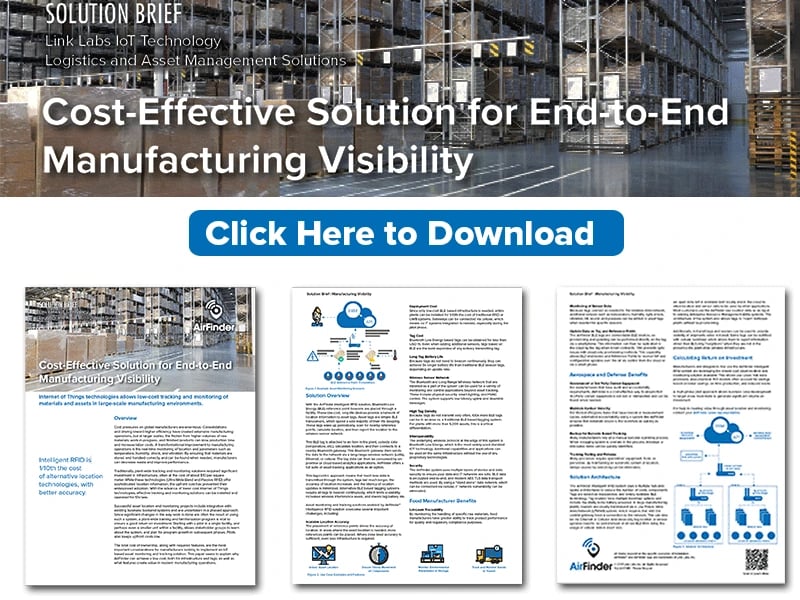Higher Accuracy and Lower Cost Tracking with Bluetooth, Cellular, and WiFi.
Location is a component of at least 70% of Internet of Things (IOT) applications. From basic fleet tracking to complex automation processes in factories, knowing location is a fundamental block in most systems. Often, location is entered manually through the act of setting up a system, but as IOT applications spread throughout the enterprise, automating location information becomes critical.
Locations Systems today often need to be multi-modal, working indoors and outdoor, in areas of installed infrastructure and in places where no infrastructure can be installed. For example, truck trailers are an ideal place to install tracking infrastructure, but are often not owned or operated by the customer looking for track materials inside it. Therefore, often pallet/package tracking system needs to connect directly to cellular (we use LTE-M).
The AirFinder IOT location systems utilizes several technologies to enable location in various scenarios:
- Bluetooth Proximity
- GPS Positioning
- WiFi Location “Lookups”
- LTE Cell ID Location
Challenges in Bluetooth Proximity
Traditional solutions that rely on Bluetooth or Zigbee proximity have several problems. These systems rely on simple beacon tags that transmit their identification every second or so. Readers are then installed throughout a facility to receive this “raw” identification data.
The raw signal data is centrally processed, and location information is calculated. The AirFinder does have a legacy mode that operates with this method:
Advantages:
- Simple, off-the-shelf Bluetooth Low Energy (LE) Tags work with this system.
- Existing Bluetooth LE devices can also be tracked with this method.
- Tag battery life is quite good.
Considerations:
- Lots of raw data is needed to get accurate location, this can drive up cellular bills for devices connected via a cellular link.
- Depending on how fast data is streamed to the server, latency can be high for beacon based systems.
- All locations need connected infrastructure, meaning that adding locations is more expensive.
New AirFinder System - A New Type of Bluetooth LE Location
The next-generation AirFinder System uses standard Bluetooth LE beacons as location reference points.
- Reference Point: A simple, and inexpensive, Bluetooth LE tag is placed in every area of location interest (for example, on per room).
- Location Aware Tag: The very same tag hardware that is used by normal Bluetooth LE beacons can be reprogrammed to instead listen for reference points. The tag then processes its own location algorithm, and then connects to an access point to relay this information.
- Access Point: Tags (and other Bluetooth sensors) connect to Bluetooth LE Access Points which are spaced about every 100 feet in a facility. These are much less dense than reference points. The Access Points receive the encrypted location (or sensor) data from the tag, and send it to the server. The connection to the server is either direct to cellular (LTE-M), Wi-Fi, or Symphony Link.
- Symphony Link: A common method of connecting Access Points in a facility is via Symphony Link, which is a LoRa (Long Range) wireless network. A single gateway can connect to dozens of access points throughout even a large facility. It is common to cover 1 million square feet or more with a single Symphony Link gateway. This gateway can be connected to cellular, and thus installing this system requires NO IT INTEGRATION.
Advantages:
- High accuracy is achievable through the use of reference points.
- Tag location updates very quickly.
- Access Point backhaul can be “multi mode”, allowing tags to transition from inside to outside, to trucks, etc.
- Cellular data usage is 100x less than a beacon based system.
- Tag Life can meet or exceed beacon based tags, depending on update rate.
- Bluetooth LE Access Points can be used to connect other Bluetooth LE sensors.
Considerations:
- Very fast update rates for tag locations impact battery life.
- Tags must be loaded with open source software to enable Pinpoint mode.
Use Case Examples:
- Healthcare
- Manufacturing
- Enterprise IT
- Logistics






